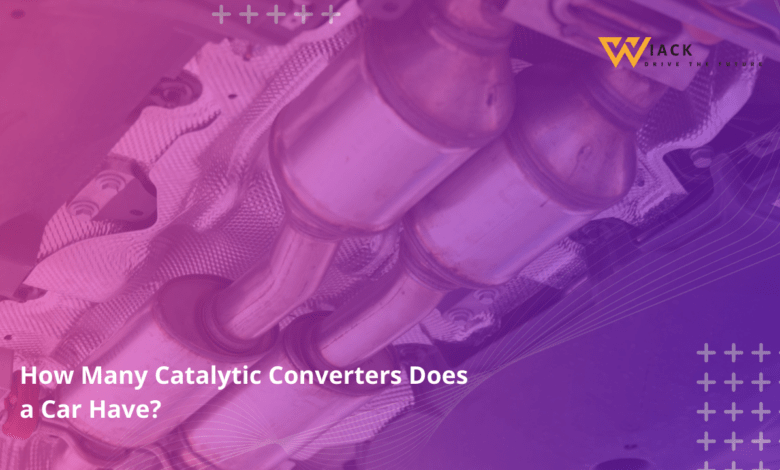How Many Catalytic Converters Does a Car Have?

Did you know that while most cars have only one catalytic converter, some high-performance vehicles can have up to four? This surprising fact highlights the complexity and variability of modern vehicle exhaust systems. In this comprehensive guide, we’ll explore everything you need to know about catalytic converters, their importance, and why some cars have more than others.
Introduction
When it comes to vehicle emissions and environmental impact, catalytic converters play a crucial role. These devices are an essential part of a car’s exhaust system, working tirelessly to reduce harmful emissions. But have you ever wondered how many catalytic converters your car might have? The answer isn’t as straightforward as you might think.
What is a Catalytic Converter?
A catalytic converter is a critical component of a vehicle’s exhaust system. It’s designed to convert toxic gases produced by the engine into less harmful substances before they’re released into the atmosphere. Think of it as a chemical filter for your car’s exhaust.
The converter contains precious metals like platinum, palladium, and rhodium, which act as catalysts. These metals facilitate chemical reactions that transform harmful pollutants into less dangerous compounds. It’s a complex process that happens in milliseconds as exhaust gases pass through the converter.
Why are Catalytic Converters Important?
Catalytic converters are vital for several reasons:
- Environmental Protection: They significantly reduce the emission of harmful pollutants like carbon monoxide, nitrogen oxides, and hydrocarbons.
- Legal Compliance: In many countries, vehicles are required by law to have functioning catalytic converters to meet emission standards.
- Public Health: By reducing air pollution, catalytic converters contribute to better air quality and public health.
- Fuel Efficiency: Modern catalytic converters can help improve a vehicle’s fuel efficiency by optimizing exhaust flow.
Understanding the importance of these devices helps us appreciate why car manufacturers invest so much in developing efficient catalytic converter configurations.
Factors Affecting the Number of Catalytic Converters
The number of catalytic converters in a car can vary depending on several factors. Let’s explore the main reasons why some vehicles might have more converters than others.
Engine Size
The size and power of an engine play a significant role in determining the catalytic converter count. Larger engines typically produce more exhaust gases, which may require additional converters to process effectively. For example:
- Small 4-cylinder engines often have one converter
- V6 or V8 engines might have two or more converters
This is why you’ll often find cars with multiple catalytic converters in high-performance or luxury vehicle categories.
Emission Regulations
Vehicle emissions regulations have a substantial impact on catalytic converter setup in vehicles. As environmental standards become stricter, car manufacturers may need to add more converters or use more advanced designs to meet these requirements.
Different regions may have varying emission standards, which can affect the catalytic converter configuration in cars sold in those areas. For instance, vehicles sold in California often have more stringent emission controls than those sold in other parts of the United States.
Vehicle Design
The overall design of a vehicle, including its exhaust system layout, can influence the number and placement of catalytic converters. Factors like:
- Engine layout (inline, V-shaped, boxer)
- Exhaust manifold design
- Available space in the undercarriage
All these elements contribute to the catalytic converter distribution in cars.
Typical Number of Catalytic Converters
Now that we understand the factors influencing catalytic converter count, let’s look at the most common configurations you’ll find in vehicles today.
One Catalytic Converter
The majority of passenger cars on the road today have a single catalytic converter. This setup is common in:
- Compact cars
- Sedans
- Small SUVs
- Most vehicles with 4-cylinder engines
A single converter is often sufficient for these vehicles to meet emission standards while keeping costs and complexity down.
Two Catalytic Converters
Cars with multiple catalytic converters, specifically two, are becoming increasingly common. You’ll often find this configuration in:
- Larger SUVs
- Luxury sedans
- Sports cars
- Vehicles with V6 or V8 engines
In these cases, one converter is typically placed close to the engine for quick warm-up, while the second is positioned further down the exhaust system for additional emission control.
More Than Two Catalytic Converters
While less common, some high-performance or large luxury vehicles may have three or even four catalytic converters. This setup is usually found in:
- High-end sports cars
- Large luxury SUVs
- Some heavy-duty trucks
These multi-catalytic converter vehicles often have complex exhaust systems designed to manage high exhaust volumes while meeting strict emission standards.
Dual Exhaust Systems
When discussing catalytic converter placement, it’s important to understand dual exhaust systems, which are common in many performance vehicles.
V-Type Engines
V6 and V8 engines often use dual exhaust systems, which can affect the number of catalytic converters in a car. In these setups:
- Each bank of cylinders may have its own exhaust manifold
- Each exhaust stream might require its own catalytic converter
This is why many V-type engines have at least two catalytic converters, one for each exhaust stream.
Y-Shaped Exhaust Pipe
Some vehicles with dual exhaust systems use a Y-shaped pipe to merge the two exhaust streams before they reach the catalytic converter. In this case:
- The vehicle may only need one larger catalytic converter
- The Y-pipe helps balance exhaust flow from both sides of the engine
This design can be a cost-effective way to manage emissions in vehicles with V-type engines while using fewer converters.
How Catalytic Converters Work
To fully appreciate the role of catalytic converters in your vehicle, it’s helpful to understand how they function. The process involves two main stages:
Reduction Catalyst
The first stage in a catalytic converter is the reduction catalyst. Here’s what happens:
- Exhaust gases enter this section first
- Platinum and rhodium help reduce nitrogen oxides (NOx)
- These harmful compounds are converted into nitrogen and oxygen
This process is crucial for reducing smog and acid rain, which are significant environmental concerns.
Oxidation Catalyst
The second stage involves the oxidation catalyst. In this phase:
- Remaining exhaust gases pass through this section
- Platinum and palladium oxidize carbon monoxide and unburned hydrocarbons
- These pollutants are converted into carbon dioxide and water vapor
While carbon dioxide is still a greenhouse gas, it’s far less harmful than the original pollutants.
Understanding these processes helps explain why catalytic converter placement is so crucial for optimal performance.
Location of Catalytic Converters
The placement of catalytic converters in a vehicle’s exhaust system is not random. Their location is carefully chosen to maximize efficiency and effectiveness.
Near the Exhaust Manifold
In most modern vehicles, you’ll find the catalytic converter(s) close to the engine, often right after the exhaust manifold. This placement is intentional and offers several advantages:
- Quick Warm-Up: Catalytic converters work best when hot. Placing them near the engine allows them to reach optimal operating temperature faster.
- Improved Efficiency: The closer to the engine, the hotter the exhaust gases. Hotter gases react more readily with the catalysts, improving overall efficiency.
- Space Efficiency: This placement often makes the best use of limited space in the vehicle’s undercarriage.
Benefits of Location
The strategic placement of catalytic converters offers several benefits:
- Faster Emissions Control: By heating up quickly, the converter can start reducing emissions almost immediately after the engine starts.
- Better Performance: Proper placement can help minimize exhaust backpressure, which can affect engine performance.
- Longevity: The right location can help protect the converter from physical damage and extreme temperature fluctuations.
Exhaust system experts carefully consider these factors when designing a vehicle’s emission control system.
Signs of a Failing Catalytic Converter
Like all car exhaust parts, catalytic converters can wear out over time. Recognizing the signs of a failing converter is crucial for maintaining your vehicle’s performance and complying with emission regulations.
Engine Warning Light
One of the most common indicators of catalytic converter issues is the illumination of the engine warning light on your dashboard. Modern vehicles have sensors that can detect when the converter isn’t functioning properly.
If you see this light, it’s best to consult with automotive repair shops or emissions control specialists to diagnose the problem.
Poor Fuel Economy
A failing catalytic converter can lead to decreased fuel efficiency. If you notice you’re filling up more often than usual, it could be a sign that your converter needs attention.
Keep an eye on your fuel consumption and consult vehicle maintenance guides if you notice a significant change.
Pungent Odor from Tailpipe
A strong, sulfuric smell (like rotten eggs) coming from your exhaust can indicate a problem with your catalytic converter. This odor occurs when the converter isn’t properly processing the exhaust gases.
If you notice this smell, it’s time to seek help from catalytic converter replacement services.
Replacing a Catalytic Converter
When a catalytic converter fails, replacement is often the only solution. Here’s what you need to know about this process:
Cost of Replacement
Replacing a catalytic converter can be expensive due to the precious metals they contain. The cost can vary widely depending on:
- Vehicle make and model
- Type of converter required
- Labor costs in your area
On average, you might expect to pay anywhere from $500 to $2,500 for a replacement, with some high-end vehicles costing even more.
Importance of Replacement
Despite the cost, replacing a faulty catalytic converter is crucial:
- Legal Requirement: In many areas, driving without a functioning converter is illegal.
- Environmental Impact: A failed converter means your vehicle is polluting more than it should.
- Vehicle Performance: A bad converter can lead to decreased engine performance and fuel efficiency.
Always consult with certified automotive repair shops or refer to car repair manuals for your specific vehicle when considering a replacement.
Conclusion
The number of catalytic converters in a car can vary from one to four, depending on factors like engine size, vehicle design, and emission regulations. While most cars have one or two converters, some high-performance vehicles may have more.
Understanding the role and importance of catalytic converters helps us appreciate their contribution to cleaner air and better vehicle performance. Whether your car has one converter or several, proper maintenance and timely replacement when needed are key to keeping your vehicle running efficiently and environmentally friendly.
Remember, if you’re ever unsure about your vehicle’s catalytic converter setup or suspect issues, don’t hesitate to consult with automotive repair shops, emissions control specialists, or refer to your vehicle’s maintenance guide. Your car—and the environment—will thank you for it!
Get the latest car news, reviews, and prices at Wiack.com. Your one-stop destination for all things automotive.





